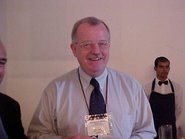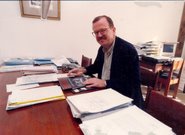

 Wendy Goldstein, Cecilia Nizzola-Tabja, building networks for CEC in regional offices and partner organizations
Wendy Goldstein, Cecilia Nizzola-Tabja, building networks for CEC in regional offices and partner organizations Dutch funding made it once more possible to have secretariat and operational support for the Commission. For over 14 years Wendy Goldstein (Australia) with the support of Cecilia Nizzola-Tabja (Peru) supported CEC. Part of the ‘deal’ on the funding in 1990 between IUCN, the CEC leadership and the Dutch government was the appointment of Frits Hesselink (Netherlands, 1945) as CEC Deputy Chair. As deputy Chair he focused on organizational improvements of the CEC network management, the CEC regionalization into the South and on linking environmental education and communication with the emerging goals of sustainable development and interactive policy making. Wendy and Cecilia proved to be excellent network managers, tirelessly supporting the emerging voluntary networks and the CEC steering committee on its new course. In Asia – under the leadership of Kartikeya Sarabhai - a regional network was formed called SASANEE and the secretariat for this network was undertaken by the Centre for Environment Education in Ahmedabad, India. The three European CEC Committees merged in 1993 under a new leadership.


 Launch of SASEANEE 1993, Latin American Network Meeting 1995, European Network meeting after merger in 1996
Launch of SASEANEE 1993, Latin American Network Meeting 1995, European Network meeting after merger in 1996Notwithstanding the substantial Dutch support and emerging regional networks, the added value of CEC to the IUCN program was unclear. In 1993 IUCN undertook a review which had the explicit intent to axe the Commission. The Secretariat commissioned a small expert committee (former IUCN DG David Munroe, former CEC Deputy Chair Julia Marton-Lefevre and outgoing CEC Chair M.A. Partha Sarathy) to come up with a proposal. Because of the recognition of the emerging new strategic direction in CEC, the Review recommended CEC not to be disbanded but to continue as an advisory body. This recommendation was not supported at the General Assembly of IUCN Members. Members could not see the difference between a Advisory Body supported by the Secretariat and a Commission, supported by the Secretariat. Therefore a CEC mandate for a full Commission – proposed by the outgoing steering committee – was approved.

 Images that lead to the advice of the reviewers not to abolish CEC but to keep it as a Strategic Advisory Committee.
Images that lead to the advice of the reviewers not to abolish CEC but to keep it as a Strategic Advisory Committee.Frits Hesselink once elected as Chair in 1994, made an effort to bring CEC back into mainstream IUCN. He focused the CEC program on support to the work of IUCN in national conservation strategies. The CEC network was refocused to service IUCN members implementing conservation (and later biodiversity) strategies by strengthening their capacities in strategic planning of environmental education and communication.




 Frits Hesselink, Strategic Planning of Education and Communication, Education for Sustainable Development
Frits Hesselink, Strategic Planning of Education and Communication, Education for Sustainable DevelopmentThis also meant a change in membership. He broke with the idea that the Chair had to approve every individual member. In practice he delegated such to the regional chairs and the secretariat. He focused membership on practitioners, much more than on ‘education scientists’. He also changed North American and European dominance in the CEC governance system. By focusing on one common global theme, new and vibrant regional networks emerged. The network in Latin America was supported by Ana Puyol as a regional secretariat post – a definite success factor. In 1994 CEC had about 120 members. In 2000 there were over 600 members with a fair gender and regional balance.
In the nineties components of IUCN focused increasingly on policy and capacity support for the Conventions on Biological Diversity, Ramsar, CITES and the ecosystem approach, creating tension with traditional programs in forests, species and wetlands. Likewise the focus of the CEC program was more and more on education and communication as social instruments - part of the instrument mix for governments to achieve environmental objectives. CEC actively engaged in capacity building to support this approach, not only within the context of the IUCN program, but also in the context of the Rio and other environmental conventions.
The internet had become a major driver for change in the management of the CEC network. The printed newsletter Nature Herald made way for electronic ones. CEC developed its first website and regional list serves. CEC experimented with the first internet debates and introduced the concept of knowledge management into IUCN. Despite all this the pressure was on from the Secretariat for the Commission to “spread the messages” from IUCN’s work. Although participation was high on IUCN’s agenda, the IUCN program was focused more on the technical aspects of conservation and less on the instrument mix of interactive policymaking. One could argue that the program was based on the assumption that information in itself will lead to change. In that sense CEC was ahead of the IUCN program.









1 comment:
Post a Comment